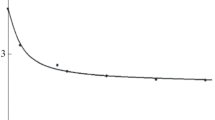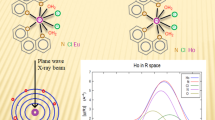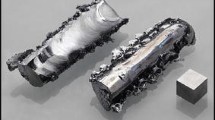Abstract
Chromium-51 decays through electron capture, the probability of which is perturbed by its electronic state. We have precisely measured the decay constants (\( {\lambda} \)) of 51Cr with metal (Cr0), oxide (Cr3+), and chromate (Cr6+) to investigate the effects of chemical states on the decay constants of 51Cr. The value of \( {{\left\{ {\lambda \left( {{\text{Cr}}^{{ 6 { + }}} } \right) - \lambda \left( {{\text{Cr}}^{ 0} } \right)} \right\}} \mathord{\left/ {\vphantom {{\left\{ {\lambda \left( {{\text{Cr}}^{{ 6 { + }}} } \right) - \lambda \left( {{\text{Cr}}^{ 0} } \right)} \right\}} {\lambda \left( {{\text{Cr}}^{ 0} } \right)}}} \right. \kern-0pt} {\lambda \left( {{\text{Cr}}^{ 0} } \right)}} \) was determined to be (6.4 ± 3.7) × 10−4, whereas the difference less than 1.4 × 10−4 was observed for \( {{\left\{ {\lambda \left( {{\text{Cr}}^{{ 3 { + }}} } \right) - \lambda \left( {{\text{Cr}}^{ 0} } \right)} \right\}} \mathord{\left/ {\vphantom {{\left\{ {\lambda \left( {{\text{Cr}}^{{ 3 { + }}} } \right) - \lambda \left( {{\text{Cr}}^{ 0} } \right)} \right\}} {\lambda \left( {{\text{Cr}}^{ 0} } \right)}}} \right. \kern-0pt} {\lambda \left( {{\text{Cr}}^{ 0} } \right)}} \).
Similar content being viewed by others
Avoid common mistakes on your manuscript.
Introduction
The decay constants of more than ten nuclides from 7Be to 235Um have been found to be changed with changing environmental factors such as its chemical state [1]. Kakiuchi and Mukoyama [2] reported the change in the decay constant of the electron capture decay nuclide 51Cr between the two chemical forms CrCl3 (valence state +3) and Na2CrO4 (valence state +6). They also estimated the value for the relative change in the decay constant among Cr0, Cr3+, and Cr6+ valence states with a simple theoretical model. The estimation shows that the relative change in the decay constant between Cr0 and Cr3+ state is approximately equal to that between the Cr3+ and Cr6+ state. However, there is no experimental value of the decay constant of Cr0 state so far. In this study, the decay constants of 51Cr have been precisely measured with Cr0, Cr3+, and Cr6+ valence states to investigate the effects of chemical states on the decay constants of 51Cr.
Experimental
The decay constants of 51Cr were measured for three chemical forms: chromium metal (Cr0), chromium (III) oxide Cr2O3 (Cr3+), and potassium chromate K2CrO4 (Cr6+). The isotope 51Cr was produced in the natCr(γ, xn)51Cr reaction.
Target materials were about 100 mg each of Cr metal, Cr2O3, and potassium dichromate K2Cr2O7. Each target material was sealed in a quartz tube and irradiated with bremsstrahlung photons. The irradiation was carried out with the electron linear accelerator at Tohoku University. The accelerator was operated at an electron energy of 30 MeV with a mean current of around 0.12 mA during the 8 h irradiation.
After the irradiation, the metal and Cr2O3 targets were maintained at 800 °C for 5 h in argon and atmosphere, respectively, with an electric furnace. The K2Cr2O7 target was mixed into 250 mg of a non-radioactive K2Cr2O7 reagent and then dissolved in 3 mL of distillated water. The solution was heated on a hot-plate and alkalified with potassium carbonate to produce \( {\text{CrO}}_{4}^{2 - } \). The solution was filtered and the filtrate was evaporated to less than 1 mL on a hot-plate. Finally, a K2CrO4 sample was prepared by recrystallization from the solution. The metal, Cr2O3, and K2CrO4 samples were placed in aluminum cups separately and sealed with an epoxy resin adhesive.
These samples were measured in pairs of Cr2O3-metal and K2CrO4-metal to reduce the influence caused by the difference of detectors. The sample pairs were set in automated sample changers [3] and alternately placed in front of a high-purity Ge (HP-Ge) detector at intervals of 7,200 s. The procedures were repeated over at least 95 days, which is longer than 3.4 times of the half-life of 51Cr (27.702 days [4]). A 137Cs source was positioned close to the HP-Ge detector as a reference source to correct for influential factors for determination of the half-life such as pile-up effects [5]. The dead-time of the measurement system was from 4 to 8 % at the beginning of the measurement. The internal clock time of the computer for data acquisition was constantly calibrated by a time-standard signal distributed via a long-wave radio transmission station in Japan.
The experiments for each of the sample pair were separately conducted two times.
Results and discussion
The decay constant of 51Cr was determined based on a reference method using a 137Cs source. The ratio R(t) is given by the following equation:
where C sample(ref)(t) and \( \uplambda_{sample(ref)} \) are count rates of a sample (reference source) at the beginning of each data acquisition and decay constant, respectively. N is the net counts in the objective peak. t R and t L are real time and live time, respectively. The decay constant t sample is described in the following equation:
where a slope is the slope of the graph of ln R(t) against time.
A typical γ-ray spectrum for a Cr-metal sample measured for the first 7,150 s is shown in the Fig. 1. The 51Cr γ peak at Eγ = 320.1 keV and the 137Cs γ peak at Eγ = 661.7 keV can be observed as two prominent peaks. Other peaks in the spectrum are ascribed to 48Cr, which is produced in the 50Cr(γ, 2n) reaction, 48V, in the 50Cr(γ, pn) reaction, and natural background radiations.
A typical decay curve for the R(t) obtained using a least-squares fitting procedure and their residuals are shown in the upper and lower panel of Fig. 2, respectively. The residuals of the fit of all the data are within the limit of approximately 0.6 %. The half-life of 51Cr with the metal form is determined to be 27.68 ± 0.02 days by the weighted average of four samples, which is in good agreement with literature value 27.702 ± 0.004 days [4].
Relative differences in the decay constant of 51Cr obtained from this work and the previous research [2] are shown in the Fig. 3. The relative difference \( {{\left\{ {\lambda \left( {{\text{Cr}}^{{ 6 { + }}} } \right) - \lambda \left( {{\text{Cr}}^{ 0} } \right)} \right\}} \mathord{\left/ {\vphantom {{\left\{ {\lambda \left( {{\text{Cr}}^{{ 6 { + }}} } \right) - \lambda \left( {{\text{Cr}}^{ 0} } \right)} \right\}} {\lambda \left( {{\text{Cr}}^{ 0} } \right)}}} \right. \kern-0pt} {\lambda \left( {{\text{Cr}}^{ 0} } \right)}} \) was determined to be (6.4 ± 3.7) × 10−4. On the other hand, the difference less than 1.4 × 10−4 at a 68 % confidence level was observed for \( {{\left\{ {\lambda \left( {{\text{Cr}}^{{ 3 { + }}} } \right) - \lambda \left( {{\text{Cr}}^{ 0} } \right)} \right\}} \mathord{\left/ {\vphantom {{\left\{ {\lambda \left( {{\text{Cr}}^{{ 3 { + }}} } \right) - \lambda \left( {{\text{Cr}}^{ 0} } \right)} \right\}} {\lambda \left( {{\text{Cr}}^{ 0} } \right)}}} \right. \kern-0pt} {\lambda \left( {{\text{Cr}}^{ 0} } \right)}} \). Kakiuchi and Mukoyama [2] reported the value of (5.3 ± 2.1) × 10−4 for \( {{\left\{ {\lambda \left( {{\text{Cr}}^{{ 6 { + }}} } \right) - \lambda \left( {{\text{Cr}}^{ 0} } \right)} \right\}} \mathord{\left/ {\vphantom {{\left\{ {\lambda \left( {{\text{Cr}}^{{ 6 { + }}} } \right) - \lambda \left( {{\text{Cr}}^{ 0} } \right)} \right\}} {\lambda \left( {{\text{Cr}}^{ 0} } \right)}}} \right. \kern-0pt} {\lambda \left( {{\text{Cr}}^{ 0} } \right)}} \), which is in good agreement with the our value of \( {{\left\{ {\lambda \left( {{\text{Cr}}^{{ 6 { + }}} } \right) - \lambda \left( {{\text{Cr}}^{ 0} } \right)} \right\}} \mathord{\left/ {\vphantom {{\left\{ {\lambda \left( {{\text{Cr}}^{{ 6 { + }}} } \right) - \lambda \left( {{\text{Cr}}^{ 0} } \right)} \right\}} {\lambda \left( {{\text{Cr}}^{ 0} } \right)}}} \right. \kern-0pt} {\lambda \left( {{\text{Cr}}^{ 0} } \right)}} \). It follows from the results that the magnitude of the correlation of the decay constants of 51Cr with Cr metal, Cr2O3, and K2CrO4 chemical forms, respectively, are determined to be \( \lambda ({\text{Cr}}^{0} ) \approx \lambda ({\text{Cr}}^{3 + } ) < \lambda ({\text{Cr}}^{6 + } ) \). In Ref. [2], the relative difference \( {{\left\{ {\lambda \left( {{\text{Cr}}^{{ 6 { + }}} } \right) - \lambda \left( {{\text{Cr}}^{ 0} } \right)} \right\}} \mathord{\left/ {\vphantom {{\left\{ {\lambda \left( {{\text{Cr}}^{{ 6 { + }}} } \right) - \lambda \left( {{\text{Cr}}^{ 0} } \right)} \right\}} {\lambda \left( {{\text{Cr}}^{ 0} } \right)}}} \right. \kern-0pt} {\lambda \left( {{\text{Cr}}^{ 0} } \right)}} \) and \( {{\left\{ {\lambda \left( {{\text{Cr}}^{{ 3 { + }}} } \right) - \lambda \left( {{\text{Cr}}^{ 0} } \right)} \right\}} \mathord{\left/ {\vphantom {{\left\{ {\lambda \left( {{\text{Cr}}^{{ 3 { + }}} } \right) - \lambda \left( {{\text{Cr}}^{ 0} } \right)} \right\}} {\lambda \left( {{\text{Cr}}^{ 0} } \right)}}} \right. \kern-0pt} {\lambda \left( {{\text{Cr}}^{ 0} } \right)}} \) were estimated to be 2.63 × 10−3 and (1.22–1.65) × 10−3, respectively, based on a Hartree–Fock-Slater approximation. There is a discrepancy between the simple theoretical estimation and our results not only of quantitative degree but also the qualitative tendency.
In conclusion, we measured the decay constants of 51Cr with the Cr metal, Cr2O3, and K2CrO4 chemical form. The difference less than 1.4 × 10−4 at a 68 % confidence level was observed for \( {{\left\{ {\lambda \left( {{\text{Cr}}^{{ 3 { + }}} } \right) - \lambda \left( {{\text{Cr}}^{ 0} } \right)} \right\}} \mathord{\left/ {\vphantom {{\left\{ {\lambda \left( {{\text{Cr}}^{{ 3 { + }}} } \right) - \lambda \left( {{\text{Cr}}^{ 0} } \right)} \right\}} {\lambda \left( {{\text{Cr}}^{ 0} } \right)}}} \right. \kern-0pt} {\lambda \left( {{\text{Cr}}^{ 0} } \right)}} \), which disagrees with the theoretical estimation in Ref. [2]. For further discussion on the relation between the decay constant and the electron state, higher-accuracy experimental data and more realistic model are required.
References
Emery GT (1972) Ann Rev Nucl Sci 22:165–202
Kakiuchi S, Mukoyama T (1981) Bull Inst Chem Res Kyoto Univ 59:27–35
Ohtsuki T, Yuki H, Muto M, Kasagi J, Ohno K (2004) Phys Rev Lett 93:112501
Firestone RB, Shirley VS (eds) (1996) Table of isotopes, 8th edn. Wiley, New York
Kikunaga H, Fujisawa H, Ooe K, Takayama R, Shinohara A, Takamiya K, Kasamatsu Y, Ezaki Y, Haba H, Nakanishi T, Mitsugashira T, Hirose K, Ohtsuki T (2011) Proc Radiochim Acta 1:113–116
Acknowledgments
The authors would like to thank the technical staff of Research Center for Electron Photon Science, Tohoku University for their excellent operation of the accelerators. This work was supported by JSPS KAKENHI Grant Number 24740136.
Author information
Authors and Affiliations
Corresponding author
Rights and permissions
About this article
Cite this article
Kikunaga, H., Takamiya, K., Hirose, K. et al. Comparison of the decay constants of 51Cr with metal, oxide, and chromate chemical states. J Radioanal Nucl Chem 303, 1581–1583 (2015). https://doi.org/10.1007/s10967-014-3570-7
Received:
Published:
Issue Date:
DOI: https://doi.org/10.1007/s10967-014-3570-7







